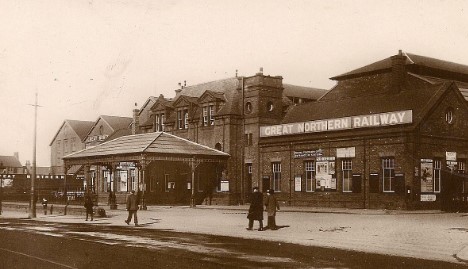A change of track
Few people in Leicester these days know the city long ago had three mainline railway stations, including a very grandiose terminus.
The old Belgrave Road station opened in 1883 and, back in the day, Leicester folk used to begin their trips to East Coast holiday resorts at the station.

But the station’s promoters had got their ideas badly wrong. It was the product of inflated traffic forecasts; its bread-and-butter local services never saw much traffic and ceased as long ago as 1953. The holiday trains followed in 1962 and the site has since been redeveloped as a supermarket and car park.
Now another Midlands city is set to get a grandiose but ill-judged railway terminus because its promoters believed it was a good idea.
Billions have already been spent on England’s high-speed railway, HS2, yet it’s slowly shrinking. Its Phase 2b (east) branch has mostly been axed and now reports say the transport secretary is minded to drop the Golborne spur, designed to feed HS2 trains heading north from Crewe on to the congested West Coast Main Line south of Wigan.
A gradualist approach is probably a poor way to set about reviewing a multi-billion pound project like HS2, but if Grant Shapps really wants to go down that line, next in the firing line really ought to be HS2’s branch to the grandiose terminus it plans at Birmingham’s Curzon Street.
Rail managers avoid termini in big cities where possible – they bedevil London’s rail network – but Curzon Street is still central to HS2 (as is the ruinously expensive plan for its new station at Euston).
Their rotten connectivity are targets of some of the biggest criticisms of HS2. Euston would be a half mile short of our one existing high-speed line, HS1, and many other connections like Thameslink and the Piccadilly Line at St Pancras.
Curzon Street is even worse placed; it doesn’t really connect with anything.
It would be a couple of hundred metres short of Birmingham’s Moor Street station but the city’s principal station, at New Street, is a long half mile away and Birmingham passengers connecting between HS2 and the rest of the rail network would need to struggle across several main roads while coping with their luggage or small children.
Indeed, their awkward hike would be even longer thanks to the vast area of landscaping planned around the huge, echoing new station whose construction has already seen several local businesses and most of a park destroyed.
And having struggled up from New Street, passengers with reservations at the front of the HS2 train could be faced with another lengthy walk. Some of its trains would be a fairly standard 200 metres long, but to get the capacity they aim for, some would be 400 metre monsters, adding a further quarter mile to the weary slog.
400 metre trains do exist elsewhere, but while they may ease capacity constraints, passengers hate them. Those who’ve staggered across Birmingham in the rain or under a hot sun would hate them even more when they discover they face a further lengthy trudge along Curzon Street’s endless platforms.
It’s true that even the rebuilt New Street does lack the capacity to accommodate high-speed trains (let alone 400 metre ones). But, as ever, alternatives were ignored. Instead of building the dysfunctional Curzon Street, some suggested the money be spent on putting Birmingham’s Cross-City Line in a tunnel under New Street, improving that service and freeing up capacity at New Street.
But HS2 and its supporters regard its design as sacred – tablets of stone brought down a mountain by an Old Testament prophet. Thou shalt conform with the blessed design or there will be wailing and gnashing of teeth.
I have been accused of opposing high-speed rail which, it’s rightly pointed out, is now enjoyed in most of Europe. Actually I don’t, although I believe the UK currently has more pressing rail investment needs. And it should have been obvious that, in a densely populated land like England, high-speed rail would always necessitate more sensitive design than it received.
HS2 would say, of course, it’s not about high-speed, it’s about capacity. ”There is no alternative.”
Well the planned speeds have certainly dropped since the plan was sold to politicians on promises of 300 mph trains, or later, 250 mph trains. Now it’s pretty much down to 200 mph trains and would most likely slide to the 180 mph European standard if any of it ever opens.
A great deal of our rail network is certainly in need of more capacity – not just the West Coast Main Line which is the majority of what HS2 would now relieve. It would do nothing for many other desperate capacity problems, like the vital Felixstowe-Nuneaton freight corridor and much else.
For we have enormous unmet rail needs. Unlike the UK, most of Europe’s network is electrified and the majority of its cities have light-rail or metro systems. They have higher levels of rail freight and few countries suffered the level of line closures the UK did. All these things need more urgent UK investment than high-speed rail, but aren’t getting it.
HS2 supporters will say they shouldn’t be alternatives. Perhaps not, but they are. The argument that scrapping bits of it couldn’t result in rail capacity investment elsewhere blew apart on 18 November last year when its Phase 2b (East) was mostly scrapped and electrification of the rest of the Midland Main Line and Trans-Pennine North, plus an East Coast Main Line upgrade, were announced as better alternatives.
Some HS2 opponents still dream of dropping it entirely. But billions have already been spent in creating a corridor from London to Birmingham. It may have been done destructively, but the swathe of destruction created should surely now best be used for some rail function, which might be high-speed trains, or a mix of high-speed and other functions.
If the Golborne spur, which would by-pass a short, congested length of the WCML is axed, it calls into question HS2 services to Scotland whose claimed ability to win internal flight passengers between London and Scotland is a key part of both the business and carbon case for HS2.
But cheese-paring is a poor way of planning anything, so a root-and-branch review of HS2 is now needed to see what’s worth saving (and what isn’t), what adaptations are needed and what the wider capacity needs of our rail network are.
We need to go back to the drawing board with a committee of rail industry experts who’ve had no connection with the HS2 bandwagon to go away and look at how the money could be better spent and the corridor created used.
If Mr Shapps wants to be remembered as a genuinely innovative transport secretary, he needs to do this and fast, before billions more are spent on creating things like Birmingham’s answer to Leicester Belgrave Road.
Jon Reeds
 Jon Reeds
Jon Reeds
 Nigel Pearce
Nigel Pearce